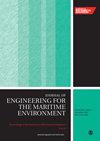LCA approach for environmental impact assessment within the maritime industry: Re-design case study of yacht’s superstructure
IF 1.5
4区 工程技术
Q3 ENGINEERING, MARINE
Proceedings of the Institution of Mechanical Engineers, Part M: Journal of Engineering for the Maritime Environment
Pub Date : 2023-05-09
DOI:10.1177/14750902231173470
引用次数: 0
Abstract
Sustainable development, one of the main challenges of our time, is a policy focused on the perfect balance between three fundamental pillars: environmental, economic and social sustainability. As regards the environmental protection, the Life Cycle Assessment (LCA) methodology allows to evaluate the sustainability profile of the overall Life-Cycle (LC) of products, processes and services, based on an inventory (in terms of materials/energy consumption and emissions/waste production) referred to all LC stages. The paper describes an application of LCA in the maritime transportation field, after a careful analysis of the state of the art. In particular, the case study consists in the environmental comparison of two alternative design solutions for the superstructure of a Azimut-Benetti yacht, designed by Corporate R&D department and manufactured in one of Benetti botyards. The competing construction options are a Glass Fiber reinforced Vinylester-isophthalic Resin (GFVR) and a Carbon Fiber reinforced Epoxy Resin (CFER) component, and they are assessed in terms of Global Warming Potential through the CML2001 Life Cyle Impact Assessment (LCIA) method. The study takes into account the entire LC of the superstructure component, divided into production (including raw materials, manufacturing and transportations), use (including both fuel consumption and exhaust air emissions) and End-of-Life (EoL). The Life Cycle Inventory (LCI) is mainly based on primary data (materials and energy consumption for manufacturing) directly provided by the construction company; missing data are retrieved from secondary sources (literature and LCI database provided by the GaBi6 environmental software). Results show that, despite the higher impact in production stage, the innovative solution allows achieving a significant quota of GWP over the entire LC (more than 16%), which is mainly associated with decreased amount of fuel needed and lowered CO2 exhaust emissions during operation. The sensitivity analysis reveals that the environmental advantage provided by the CFER design becomes bigger as both component life-time and yacht consumption increase.航运业环境影响评估的LCA方法:游艇上层建筑的重新设计案例研究
可持续发展是我们这个时代的主要挑战之一,它是一项注重在环境、经济和社会可持续性这三个基本支柱之间取得完美平衡的政策。在环境保护方面,生命周期评估(LCA)方法可根据所有生命周期阶段的清单(按物料/能源消耗和排放/废物产生计算),评估产品、过程和服务的整个生命周期的可持续发展概况。本文在详细分析了LCA在海上运输领域的应用现状的基础上,介绍了LCA在海上运输领域的应用。特别是,案例研究包括Azimut-Benetti游艇上层结构的两种替代设计方案的环境比较,该游艇由公司研发部门设计,并在Benetti船厂之一制造。竞争的结构选择是玻璃纤维增强的vinylest -isophthalic Resin (GFVR)和碳纤维增强的环氧树脂(CFER)组件,它们通过CML2001生命周期影响评估(LCIA)方法根据全球变暖潜势进行评估。该研究考虑了上层建筑部件的整个LC,分为生产(包括原材料,制造和运输),使用(包括燃料消耗和废气排放)和寿命结束(EoL)。生命周期库存(LCI)主要基于建筑公司直接提供的原始数据(制造材料和能源消耗);缺失的数据从次要来源检索(文献和由GaBi6环境软件提供的LCI数据库)。结果表明,尽管在生产阶段的影响较大,但创新的解决方案可以在整个LC中实现显著的GWP配额(超过16%),这主要与运行过程中所需燃料量的减少和二氧化碳排放的降低有关。灵敏度分析表明,随着部件寿命和游艇消耗的增加,CFER设计提供的环境优势越来越大。
本文章由计算机程序翻译,如有差异,请以英文原文为准。
求助全文
约1分钟内获得全文
求助全文
来源期刊

CiteScore
3.90
自引率
11.10%
发文量
77
审稿时长
>12 weeks
期刊介绍:
The Journal of Engineering for the Maritime Environment is concerned with the design, production and operation of engineering artefacts for the maritime environment. The journal straddles the traditional boundaries of naval architecture, marine engineering, offshore/ocean engineering, coastal engineering and port engineering.
 求助内容:
求助内容: 应助结果提醒方式:
应助结果提醒方式:


